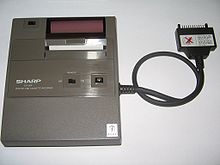- Thermal printer
-
- For the type of printer which uses sparks and aluminised paper (and is sometimes referred to as a "thermal printer"), see spark printer.
Part of a series on the History of printing 
Woodblock printing (200) Movable type (1040) Printing press (1454) Etching (ca. 1500) Mezzotint (1642) Aquatint (1768) Lithography (1796) Chromolithography (1837) Rotary press (1843) Offset printing (1875) Hectograph (19th century) Hot metal typesetting (1886) Mimeograph (1890) Screen printing (1907) Spirit duplicator (1923) Dye-sublimation (1957) Phototypesetting (1960s) Dot matrix printer (1964) Laser printing (1969) Thermal printing (ca. 1972) Inkjet printing (1976) Stereolithography (1986) Digital press (1993) 3D printing (ca. 2003) A thermal printer (or direct thermal printer) produces a printed image by selectively heating coated thermochromic paper, or thermal paper as it is commonly known, when the paper passes over the thermal print head. The coating turns black in the areas where it is heated, producing an image. Two-color direct thermal printers can print both black and an additional color (often red) by applying heat at two different temperatures.
Thermal transfer printing is a related method that uses a heat-sensitive ribbon instead of heat-sensitive paper.[1]
Contents
Essential mechanisms
A thermal printer comprises these key components:
- Thermal head — generates heat; prints on paper
- Platen — a rubber roller that feeds paper
- Spring — applies pressure to the thermal head, causing it to contact the thermo-sensitive paper
- Controller boards — for controlling the mechanism
In order to print, thermo-sensitive paper is inserted between the thermal head and the platen. The printer sends an electrical current to the heating elements of the thermal head, which generate heat. The heat activates the thermo-sensitive coloring layer of the thermo-sensitive paper, which changes color where heated. Such a printing mechanism is known as a thermal system or direct system. The heating elements are usually arranged as a matrix of small closely spaced dots—thermal printers are actually dot-matrix printers, though they are not so called.
The paper is impregnated with a solid-state mixture of a dye and a suitable matrix; a combination of a fluoran leuco dye and an octadecylphosphonic acid is an example. When the matrix is heated above its melting point, the dye reacts with the acid, shifts to its colored form, and the changed form is then conserved in metastable state when the matrix solidifies back quickly enough. See thermochromism.
Controller boards are embedded with firmware to manage the thermal printer mechanisms. The Firmware can manage multiple bar code types, graphics and logos. They enable the user to choose between different resident fonts (also including Asian fonts) and character sizes.
Controller boards can drive various sensors such as paper low, paper out, door open, top of form etc., and they are available with a variety of interfaces, such as RS-232, parallel, USB and wireless. For point of sale application some boards can also control the cash drawer.
Applications
Thermal printers print more quietly and usually faster than impact dot matrix printers. They are also smaller, lighter and consume less power, making them ideal for portable and retail applications. Cost of thermal paper, their only consumable, was somewhat less than US$0.10 per sheet as of 2010[update].[2] By comparison, one study of the per page cost of color inkjet printers [3] found cost of third-party ink cartridge and paper to be about $0.05 per page (some low-capacity cartridges are more expensive to use). Roll-based printers can be rapidly refilled. Commercial applications of thermal printers include filling station pumps, information kiosks, point of sale systems, voucher printers in slot machines, print on demand labels for shipping and products, and for recording live rhythm strips on hospital cardiac monitors.
Through the 1990s many fax machines used thermal printing technology. Toward the beginning of the 21st century, however, thermal wax transfer, laser, and inkjet printing technology largely supplanted thermal printing technology in fax machines, allowing printing on plain paper.
The Game Boy Printer, made in 1998, was a small thermal printer used to print out certain elements from some Game Boy games.
Early formulations of the thermo-sensitive coating used in thermal paper were sensitive to incidental heat, abrasion, friction (which can cause heat, thus darkening the paper), light (which can fade printed images), and water. Later thermal coating formulations are far more stable; theoretically, thermally printed text should remain legible at least 50 years[citation needed].
Hospitals commonly record fetal ultrasound scan images on thermal paper. This can cause problems if the parents wish to preserve the image by laminating it, as the heat of most laminators will darken the entire page—this can be tested for beforehand on an unimportant thermal print. An option is to make and laminate a permanent ink duplicate of the image.
Health concerns
Reports began surfacing of studies in the 2000s finding the oestrogen-related chemical Bisphenol A ("BPA") mixed in with thermal (and some other) papers. While the health concerns are very uncertain, various health and science oriented political pressure organizations such as the Environmental Working Group have pressed for these versions to be pulled from market. [4] [5]
References
- ^ What Are Direct Thermal and Thermal Transfer RFID Printers?, RFID Radio
- ^ price list
- ^ [1]
- ^ http://www.sciencenews.org/view/generic/id/48084/title/Science_%2B_the_Public__Concerned_about_BPA_Check_your_receipts
- ^ http://www.ewg.org/bpa-in-store-receipts
See also
Categories:- Computer printers
- Non-impact printing
- Thermochromism
Wikimedia Foundation. 2010.

